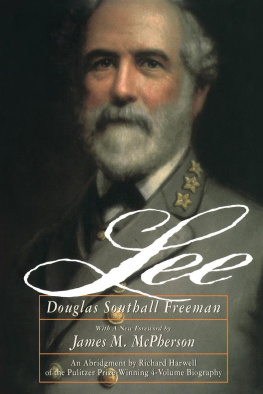This edition is published by PICKLE PARTNERS PUBLISHINGwww.pp-publishing.com
To join our mailing list for new titles or for issues with our bookspicklepublishing@gmail.com
Or on Facebook
Text originally published in 1942 under the same title.
Pickle Partners Publishing 2016, all rights reserved. No part of this publication may be reproduced, stored in a retrieval system or transmitted by any means, electrical, mechanical or otherwise without the written permission of the copyright holder.
Publishers Note
Although in most cases we have retained the Authors original spelling and grammar to authentically reproduce the work of the Author and the original intent of such material, some additional notes and clarifications have been added for the modern readers benefit.
We have also made every effort to include all maps and illustrations of the original edition the limitations of formatting do not allow of including larger maps, we will upload as many of these maps as possible.
LEES LIEUTENANTS
A STUDY IN COMMAND
BY
DOUGLAS SOUTHALL FREEMAN
VOLUME THREE GETTYSBURG TO APPOMATTOX
MAPS
Battlefield of Brandy Station
Approaches to Brandy Station from Kellys Ford
Battlefield of Second Winchester and of Stephensons Depot
Routes to Carlisle, Harrisburg, Gettysburg, York
Route of Stuarts Raid from Salem, Va., to Gettysburg
Heths feelingout advance toward Gettysburg
Attack of Rodess Division near Gettysburg
Gettysburg and vicinity
Attack of Confederate right, South of Gettysburg
Attack of Confederate left on Culps Hill and Cemetery Hill
Lines of Advance of Pickett, Pettigrew, and Trimble
Advance of Second and Third Army Corps to Bristoe Station
Attack of Cooke and Kirkland at Bristoe Station
Vicinity of Auburn, where Stuart thought his force surrounded
Scene of Mine Run operations, Nov. 26Dec. 2, 1863
Vicinity of Chattanooga with reference to Longstreets operations
Regions of Longstreets operations from Wauhatchie, Tenn., to Abingdon, Va.
Terrain of WildernessSpotsylvania operations, May 421, 1864
Trench system at close of Battle of the Wilderness
Grants alternative Routes to Richmond
Lees Road from Vicinity of Parkers Store to Catharpin Road
Engagement of Confederate Cavalry and V Federal Corps
Final Confederate works at Mule Shoe or Bloody Angle
Sheridans raid and Stuarts Pursuit, May 911, 1864
Completed trench system around Spotsylvania Court House
Principal Southern railway connections of Richmond
The Richmond and Petersburg and the Petersburg and Weldon Railroads
Railroad connections of Richmond within Virginia
District between Drewrys Bluff and Petersburg
Vicinity of Louisa Court House and Trevilian Station
Sketch to illustrate first stages of Earlys Advance, June, 1864
Streams and roads between Appomattox and Nottoway Rivers
Battlefield of Monocacy, July 9, 1864
Lower Shenandoah Valley, scene of Earlys operations
Confederate infantry positions, Third Battle of Winchester
Battlefield of Fishers Hill, Sept. 22, 1864
Earlys plan for attacking Federal camps on Cedar Creek
Federal lines of battle and successive positions of VI Corps
Approaches to Southside Railroad from Dinwiddie Court House
Fort Gregg and Confederate lines South-west of Petersburg
Change of route, April 5, 1865, of Army of Northern Virginia
Vicinity of Saylors Creek, battle of April 6, 1865
Crossings of Appomattox River in vicinity of Farmville
Terrain North of Farmville
Sketch of vicinity of Appomattox Court House
Battlegrounds of the Army of Northern Virginia at end of volume
INTRODUCTION
WHEN THIS NARRATIVE opens in June, 1863, the Army of Northern Virginia had been reorganized into three Corps. Gen. R. E. Lee was conscious of the immense loss the Southern Confederacy had sustained in the death of Stonewall Jackson, and he doubtless was aware of the weight of his words when he said of his fallen lieutenant, I know not how to replace him. Hopeful that God would raise up someone in Jacksons place, Lee had to rely during a critical summer on the experience of the troops to offset the change in officers. He believed his troops invincible; he had to test newly promoted lieutenants and a veteran corps commander who had been leading a semi-independent army. To a certain point the events of June are presented, for these reasons, as a study of the state of mind of three men, Jeb Stuart, Ewell and Longstreet.
Unless it was the tone of Longstreets correspondence during the operations in front of Suffolk in the spring of 1863, nothing in the previous conduct of these officers could have prepared their commander or their subordinates for what happened in Pennsylvania. Stuart almost certainly was prompted to undertake a long raid in order to restore the reputation he felt had been impaired in the Battle of Brandy Station. Dick Ewell made an advance that equalled in dash and decision almost any achievement of his predecessor Jackson, and then, in a single hour, Ewell appeared to be a changed man. He was irresolute and unable to exercise the discretion Lees system of command allowed him. Longstreet, in turn, sought to procure an advantage of ground similar to that which he had enjoyed at Fredericksburg. He mistakenly believed that he had gained the commanding Generals approval of a tactical defensive if there had to be a strategic offensive.
These three states of mind were disclosed during the preliminaries of a campaign which brought the Army of Northern Virginia into fateful collision with its adversary at Gettysburg. The absence of Stuart, the indecision of Ewell and the sulking of Longstreet complicated adverse conditions of combat; but the traditional easy explanation of defeat at Gettysburg as the direct and exclusive result of the shortcomings of these three men cannot be sustained. On the contrary, as respects Longstreet, who often was presented as the villain of the piece, a review of all the material evidence rehabilitates him to this extent: Although he did not realize how far and how fast the Federal left had been extended southward on Cemetery Ridge during the night of July 1 and the early morning of July 2, he was correct in maintaining that the position could not be taken by assault. As Appendix II shows, the Union left from early morning was stronger than the Confederates assumed. The record definitely qualifies the familiar assertion that on the whole of the Federal left, South of the little clump of trees, more and more Federal troops arrived while Longstreet delayed his deployment. The Confederates probably were unable to see much of the lower end of the Federal position on Cemetery Ridge for the reason given in Appendix I; but the Union troops, whether visible or not, were there in strength. Almost certainly they could have repulsed any attack that could have been made on them at the earliest hour at which Longstreet could have put McLaws and Hood into action.













